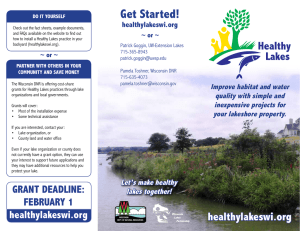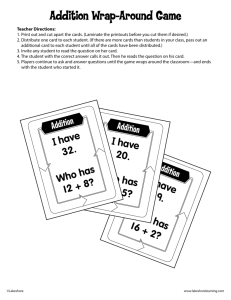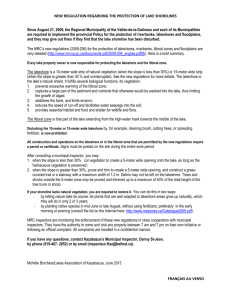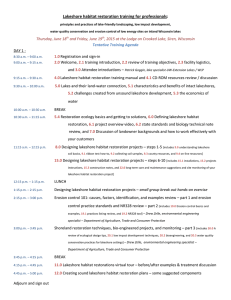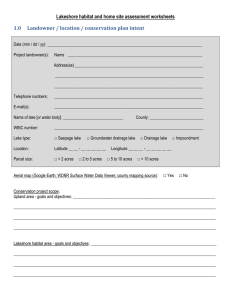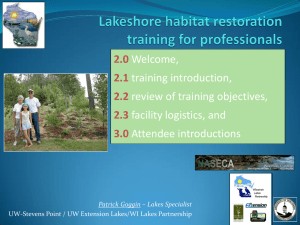Wisconsin Lake Leaders – lakeshore / shoreland station
advertisement
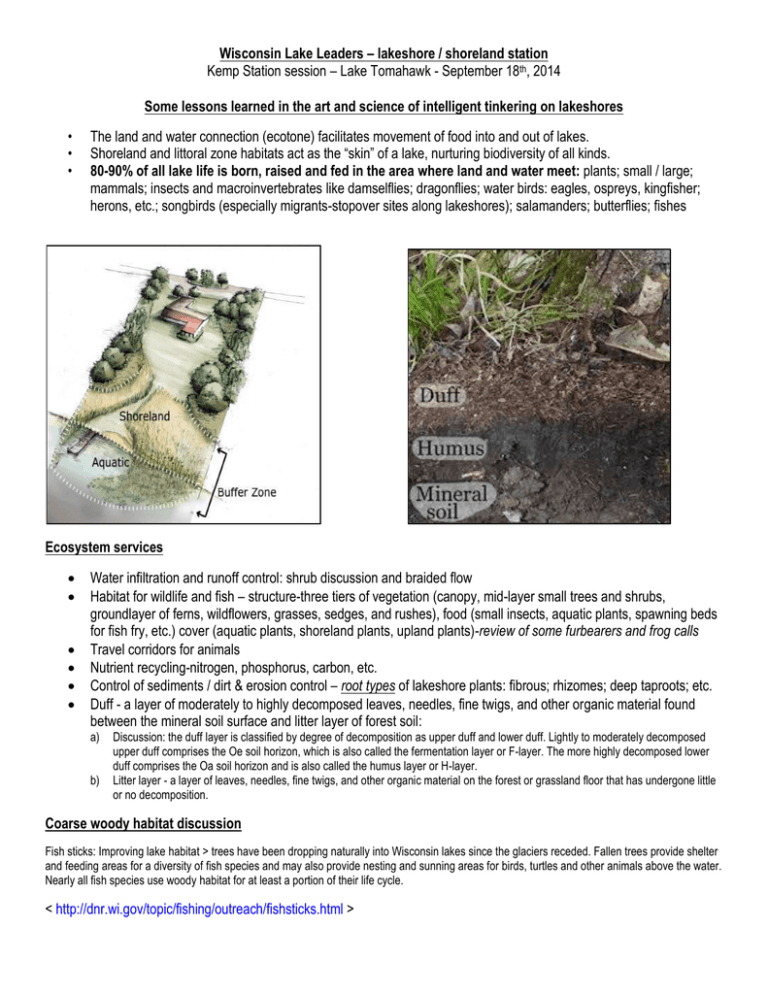
Wisconsin Lake Leaders – lakeshore / shoreland station Kemp Station session – Lake Tomahawk - September 18th, 2014 Some lessons learned in the art and science of intelligent tinkering on lakeshores • • • The land and water connection (ecotone) facilitates movement of food into and out of lakes. Shoreland and littoral zone habitats act as the “skin” of a lake, nurturing biodiversity of all kinds. 80-90% of all lake life is born, raised and fed in the area where land and water meet: plants; small / large; mammals; insects and macroinvertebrates like damselflies; dragonflies; water birds: eagles, ospreys, kingfisher; herons, etc.; songbirds (especially migrants-stopover sites along lakeshores); salamanders; butterflies; fishes Ecosystem services Water infiltration and runoff control: shrub discussion and braided flow Habitat for wildlife and fish – structure-three tiers of vegetation (canopy, mid-layer small trees and shrubs, groundlayer of ferns, wildflowers, grasses, sedges, and rushes), food (small insects, aquatic plants, spawning beds for fish fry, etc.) cover (aquatic plants, shoreland plants, upland plants)-review of some furbearers and frog calls Travel corridors for animals Nutrient recycling-nitrogen, phosphorus, carbon, etc. Control of sediments / dirt & erosion control – root types of lakeshore plants: fibrous; rhizomes; deep taproots; etc. Duff - a layer of moderately to highly decomposed leaves, needles, fine twigs, and other organic material found between the mineral soil surface and litter layer of forest soil: a) b) Discussion: the duff layer is classified by degree of decomposition as upper duff and lower duff. Lightly to moderately decomposed upper duff comprises the Oe soil horizon, which is also called the fermentation layer or F-layer. The more highly decomposed lower duff comprises the Oa soil horizon and is also called the humus layer or H-layer. Litter layer - a layer of leaves, needles, fine twigs, and other organic material on the forest or grassland floor that has undergone little or no decomposition. Coarse woody habitat discussion Fish sticks: Improving lake habitat > trees have been dropping naturally into Wisconsin lakes since the glaciers receded. Fallen trees provide shelter and feeding areas for a diversity of fish species and may also provide nesting and sunning areas for birds, turtles and other animals above the water. Nearly all fish species use woody habitat for at least a portion of their life cycle. < http://dnr.wi.gov/topic/fishing/outreach/fishsticks.html > Human uses / values Natural screening Wildlife viewing, fishing, swimming Solitude / quiet place Impacts include: wildlife diversity decline; water quality degradation; less vegetation—especially less shrub and ground layers; woody habitat along shore; more lake users on the water; ‘death by a thousand cuts’ w/ population growth and housing density rise Link between healthy shorelines and our quality of life: helps support our tourism industry; provides recreation users [water sports, fisherman, boaters, etc.] with a good experience; gives a pleasing environment/aesthetics; provides wildlife habitat; enhances water quality Development of shoreland areas discussion Housing density changes: a) from 3-season cabins to second homes; b) number of homes per linear mile – from 10-20 now up to 30-50; c) nutrients and sediment changes (5X to 18X increases) National Lakes Assessment fact sheet review • Degradation of lakeshore habitat cover is the most important stressor of lakes. Shorelands and Shallows web resources: < http://www.uwsp.edu/cnr-ap/UWEXLakes/Pages/ecology/shoreland/default.aspx > Defining shoreland buffer restoration Practice that uses native trees, shrubs, and groundcover, along with natural and biodegradable materials (biologs, deltalock bags, sediment logs, soil lifts, woody material), to reduce lakeshore erosion and improve aquatic and wildlife habitat quality. Why native plants? The research of Doug Tallamy on why native plants are so important – some examples in handout… Ten common themes of effective lakeshore habitat restoration projects 1. Partnerships get it done Holistic and inclusive lake community partnerships can support lakeshore restoration work of all kinds. Be open to possible project helpers like lake organizations, scouting groups, master gardeners, wildlife, angler, and hunting clubs, churches and other community organizations. 2. Funding can take many forms State DATCP funds; WDNR grants – highlight new grant package coming through WDNR Lake Health Lean Government Initiative Lakeshore rehabilitation projects are good for local economies and small business owners. Expenditures from these lake projects provide income to area contractors, nurseries, landscapers, erosion control specialists, and others employed in facets of the work. 3. Creating a strong conservation plan pays dividends / making a lakeshore restoration plan is critical Landowner information and integrating their goals & needs; diggers hotline reminder; estimated quantities of materials & labor; base maps; construction notes & process; planting plans; state and local standards to meet; permitting; project instructions; legal and financial needs; priorities and timelines; etc. Operation and maintenance plans; targets for monitoring and identifying project success 4. Use ecological design principles Incorporating ecological design principles of water infiltration, retention, reuse, and flow control into our strategies with landowners pays dividends. This includes low impact development (LID) approaches and practices that are targeted to reduce runoff of water and pollutants like rain gardens and barrels, permeable pavements, green roofs, living walls, infiltration planters, drain systems, water bars, brush bundles, gutters, and cisterns. Woody habitat – new protocol for doing “fish sticks” projects 5. Landowner values are met Landowners are essential to any restoration strategy; without willing lakeshore property owners, opportunities for rehabilitating lakeshore habitat are minimal. Finding local, on-lake champions of lakeshore rehabilitation work like lake association officers or master gardeners can make for effective peer-to-peer learning and with this project had less success with securing landowners because no effective local lake champion could be found to make the case for recruiting suitable lakeshore property owners. Natural resource educators, contractors, planners, and other consultants to these landowners need to be hands-on with their assistance. They must openly communicate with landowners to understand their vision for their lakeshore properties on access points, view corridors, plant selection, storage needs, landscaping preferences, and other facets of the project. For example, we need to meet landowners where their landscape values are, whether they champion a “messy look” closer to a wild lakeshore or a “tidy” aesthetic that might accentuate drifts of plants, delineated edgings, and lower growing native vegetation. “Cues to care” ideas: to give the project a “neater” aesthetic – drifts of plants clumped together; edging along buffer; eye candy plants like cardinal flower; etc. 6. Maintenance and monitoring is required Incorporating maintenance needs and monitoring ideas into a project from the beginning (i.e., monitoring for ample watering regimes; invasive species control needs; browse protection systems like spray deterrents, temporary fencing, or motion-sensory sprinkler plans; proper dock storage; etc.). Before/after species lists tracked by the landowner Feeding deer in proximity to restored lakeshore habitats can make restoration more difficult because of browsing damage. Identifying signs of trouble and what to do about it 7. Address erosion control concerns Finding erosion control solutions for landowners to challenges from ice heave and wave action are critical to success. This fact often brings willing landowners to the table for doing shoreland rehabilitation so we need to make sure we address these concerns effectively. Innovative advances in erosion control materials that meet state standards and codes can be found by partnering with land and water conservation departments, consultants, and others. 8. Communication – Between contractor and landowner; county and landowner; project planner and installer and landowner; etc. Balancing act between lake viewing, access, and scenic beauty and use of the parcel. John and Bret’s handout: watching the grand kids; ticks; smaller plantings/top ten plants; animal favorites; pests 9. Involve the lake community • Holistic and inclusive lake community partnerships can support lakeshore restoration work of all kinds. Be open to possible project helpers like lake organizations, scouting groups, master gardeners, churches and other community organizations. 10. Take an adaptive approach Patrick Goggin - Lake Specialist / Wisconsin Lakes Partnership > UW-Extension Lakes / College of Natural Resources > UW-Stevens Point / c/o WDNR Rhinelander Service Center / 107 Sutliff Avenue / Rhinelander WI / 54501 / (715)-365-8943 UWEX Lakes web site < http://www.uwsp.edu/cnr/uwexlakes/ > / Email: < pgoggin@uwsp.edu >
